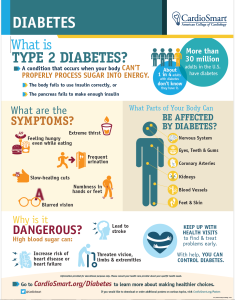Why People with Type 2 Diabetes Need to be Smart about Their Heart
Diabetes is among the strongest risk factors for heart and vascular disease – up there with smoking and having high blood pressure or high cholesterol. Cardiovascular disease is the top cause of death among people with type 2 diabetes. Compared with those who do not have diabetes, women with the condition have about four times greater risk for heart disease, while men with the condition have about twice the risk.
“People with diabetes often have other risk factors, like high cholesterol, being overweight, not exercising, and smoking, which collectively can increase the risk for heart disease,” says Rachel Bond, MD, FACC, member of the American College of Cardiology (ACC) and the ACC’s CardioSmart editorial board. “The high blood glucose levels associated with diabetes cause damage, in the form of inflammation, to the inner linings of the blood vessels. That inflammation leads to heart disease and other forms of cardiovascular disease that affect all vessels in the body, including those in the brain, arms, and legs, a condition known as peripheral arterial disease.”
Control Your Glucose Levels to Protect Your Heart
Dr. Bond says that people with type 2 diabetes can do several things to reduce their risk for cardiovascular disease, including lifestyle modification. Most important, she says, is to make sure that blood glucose levels are under strict control by adopting a heart-healthy diet low in carbohydrates and saturated fat and high in whole grains. Plant-based and Mediterranean diet plans are an excellent way to achieve those dietary goals. She also recommends maintaining 150 minutes per week of moderate physical activity.
“Research data suggests that patients with a history of diabetes, especially if they are over 40, should also be on lipid-lowering medications called statins for primary prevention of heart disease,” Dr. Bond says. “These drugs, which help to lower cholesterol, also mitigate the inflammatory process caused by high blood glucose levels.”
According to guidance from the ACC and the American Heart Association, the longer someone has diabetes, the higher their risk for a cardiovascular event. This means that doctors may need to be even more aggressive in treatments designed to lower cholesterol and blood pressure.
The same guidance recommends the use of additional steps – beyond traditional blood work – to better stratify a diabetic patient’s risk of developing heart disease. Today, those steps include the use of imaging to detect the amount of plaque buildup in the vessels. Those imaging tests provide a coronary artery calcium score, which can be used to guide recommendations for lipid-lowering medications.
CardioSmart Resources Aid in Shared Decision-Making
Understanding the heart disease risks associated with type 2 diabetes is the first step people can take to better care for their health, according to Dr. Bond. The infographic below, one of many resources available through the ACC’s CardioSmart program, does a good job of illustrating the connection between the two conditions.
©2019 American College of Cardiology Foundation
(Click thumbnail to view full sized image)
In addition to this and other infographics that show patients what heart disease looks like and how lifestyle management and medications can lower their risk of cardiac disease, CardioSmart offers a variety of decision-aid tools that physicians can use to engage with patients during office visits.
“Shared decision-making is crucial, and the ACC encourages patients to advocate for themselves in all treatment decisions,” Dr. Bond says. “The step-by-step decision aids available through CardioSmart are easy to understand and empower both patients and providers to work together to design a course of action that will work best to improve health outcomes on an individual basis.”
CardioSmart also offers a free downloadable Action Plan to help patients manage their diabetes and protect their heart. Patients can use the workbook to write down their goals and map out a plan to lower their risk of diabetes-related heart problems. Also available: a 10-step checklist of actions patients can take to lower their chance of diabetes-related heart problems. Additional information, tools, and resources to help people with diabetes are available through CardioSmart’s Diabetes and Your Heart web portal.
Health Disparities in Focus
According to Dr. Bond, modifiable cardio-metabolic risk factors like diabetes disproportionately affect specific patient populations, including Black, Hispanic, Indigenous, and lower-income communities. CardioSmart has been helping to educate health care providers about these health disparities, as well as gender-based disparities, so they are better aware of and attuned to them. For example, women typically have a much higher likelihood than men of having cardiovascular disease if they have diabetes. Despite this evidence, women are less aggressively treated.
“Providers need to go beyond counseling these patients on diet, exercise, and medication compliance,” she says. “We also need to ask them about their environment and culture, which may play into why they have diabetes to begin with. This is a crucial step toward mitigating those disparities.”
Know What Your Numbers Mean
Dr. Bond suggests that everyone, regardless of whether or not they have been diagnosed with diabetes or heart disease, take ownership of their health by seeing a doctor every year for a wellness check that includes measurements of blood pressure, heart rate, height, and weight, as well as a blood test and other screenings.
“It’s important to know all your numbers, but it’s even more important to understand what those numbers mean to put your risk factors into perspective,” she says. “Be honest about your family history, current environment, level of daily activity, and diet. All of these details will help your doctor suggest steps you can take to reduce your risks of diabetes and cardiovascular disease.”



















